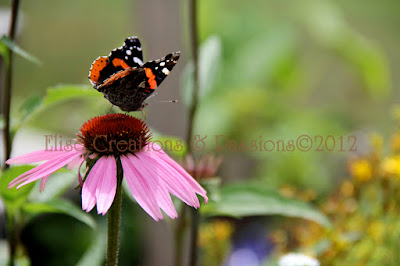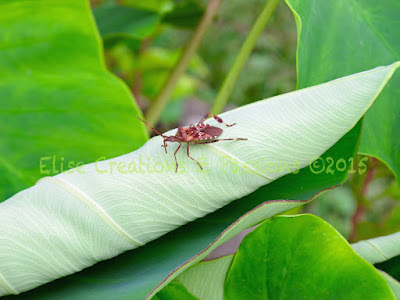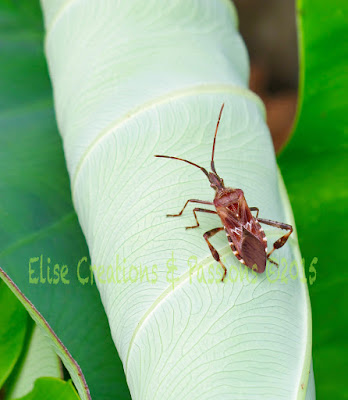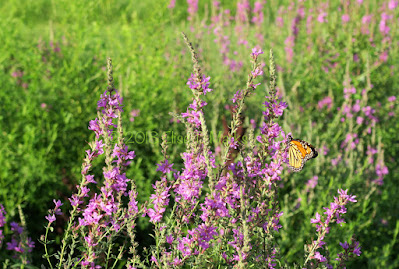Lichen Moth
(Lycomorpha Pholus) on Bush Honeysuckle. Some lichen moths have evolved to mimic poisonous insects as a way to avoid being eaten.
Colorado Potato Beetle
Hoverfly On Agrimony
Leaf footed Bug Acanthocephala terminalis On Lilac
Assassin Bug Nymph
Katydid or bush cricket, & A Bee On Hibiscus
In my garden.
Hoverfly On AgrimonyBlue Black Wasp On Coreopsis
Big Black Beetle on St John's Wort plant. If you know what kind of beetle this is, please tell me.
Dogbane Beetle
Western Conifer Seed BugThe Western Conifer Seed Bug feeds on the sap of developing conifer cones throughout its life, and its sap-sucking causes the developing seeds to wither and misdevelop. It is therefore considered a minor tree pest in North America.Grapevine Beetle or Spotted June Beetle on grapevine leaves. Orange-collared Scape Moth
(Cisseps fulvicollis)
on Goose Neck Loosetrife (Lysimachia clethroides)
It has long black wings, an abdomen of iridescent blue, and a bright yellow or orange collar, from which it takes its name. It's other common name is, Yellow-Collared Scape Moth.
The Yellow or Orange-collared Scape Moth is widespread in North America.
Habitat includes fields with flowers as adults are commonly seen visiting flowers during the day, while they also fly at night and are attracted to light.
Season for the adults is from May to October or until the first hard frost.
Adults feed on goldenrod and other small nectar bearing flowers.
The larvae feed on grasses, lichens, and spike-rushes.
(Cicindela sexguttata)
The green tiger beetle is a large beetle with a metallic-green body, long blue-green spindly legs, and long, serrated antennae, and large mandibles. This common green ground beetle is also called the six-spotted green tiger beetle due to the recognizable cream-colored spots on its elytra.
The sizable, fast-moving shiny green tiger beetle grows up to 0.55” (14 mm). It is typically found in deciduous forests, feeding on small arthropods like caterpillars, spiders, and ants. The green tiger beetle is one of the fastest ground beetles and will fly if necessary.
Ladybug On A Wet Canna Leaf
Ladybugs also known as Ladybird beetles, Lady beetles, Ladybirds, or Lady cows, can have as many as 16 spots, but some ladybugs have no spots at all. One of the most common ladybugs is the seven-spotted lady beetle. It has seven black spots on its back.
While most ladybugs are good, there is one nonnative species that people don’t like. The Asian lady beetle was introduced in California in 1916. Today it’s more common in the East.
A ladybug can eat up to 50 aphids a day. They also eat Mites, Whiteflies, Scale insects, Mealybugs, & Thrips. This makes them valuable allies for farmers and gardeners. Their presence in an ecosystem is a sign of a healthy and diverse environment. Ladybugs not only provide natural pest control benefits to humans, but also serve as a vital food source for other insects, birds, and small mammals. By maintaining a delicate balance in the ecosystem, ladybugs promote stability and overall well-being.
Females will lay up to 1,000 eggs within a few months, generally from spring to early summer.
Ladybugs usually protect themselves from predators by either playing dead or they secrete a fluid from their legs to make themselves taste bad.
You can find out about 6,000 different species of ladybugs around the world. There are about 500 species in the United States alone.
It is a myth about ladybugs is that you can tell their age by their number of spots.
The Most Interesting Caterpillar I've seen is the Io moth (pronounced as EYE-oh), Also known as the peacock moth. The name Io comes from Greek mythology in which Io was a mortal lover of Zeus. Once hatched, these caterpillars begin feeding voraciously on the leaves of their host plants. They consume a wide range of vegetation, including oak, holly, boxelder, elm, maple, aspen, alder, hickory, willow, locust, cherry, pear, sassafras, and sweetgum trees, as well as others. These caterpillars go through several instars, shedding their skin as they grow, becoming more robust and colorful as they progress through these stages. It has venomous spines that provide protection against potential predators. Do not handle Io Moth caterpillars, as its poisonous spines causes skin irritation and a lot of pain.
My photographs are available for purchase
You can see more of my creations at:
or
Thanks for your visits, favs and comments. As always, appreciated very much!
© all rights reserved by Elise T. Marks.
Please do not use this image on websites, blogs or any other media without my explicit written permission.



























































